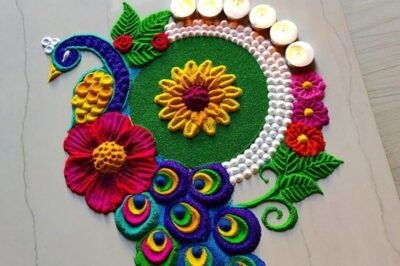Rangoli art is a vibrant and symbolic form of expression that holds deep cultural significance in Indian festivals. This traditional Indian art has been practiced for centuries, especially during auspicious occasions like Diwali, Navratri, and Pongal. As one of the most popular forms of Indian festive decorations, Rangoli represents prosperity, luck, and the welcoming of divine blessings into the home. Whether created in simple geometric patterns or intricate designs, the beauty and cultural importance of Rangoli are undeniable.
The Cultural Roots of Rangoli Art
Rangoli is more than just decorative art; it carries deep cultural and spiritual meaning. Derived from the Sanskrit word “Rangavalli,” meaning rows of color, Rangoli art is typically created at the entrance of homes or temples to invite positive energy and ward off negativity. The practice of drawing Rangoli during festivals is a way to honor deities and seek their blessings for prosperity and well-being.
The art form is passed down through generations, symbolizing the preservation of tradition and the continuity of Indian culture. It also brings families and communities together, as people often collaborate on creating large, vibrant festival Rangoli designs that reflect the joy of the occasion.
Rangoli Art During Diwali
Among the many festivals where Rangoli art plays a prominent role, Diwali holds a special place. Diwali, the festival of lights, is marked by beautiful Diwali Rangoli ideas, where people decorate their homes with colorful patterns to celebrate the victory of light over darkness. Rangoli designs during Diwali often depict traditional motifs such as diyas (oil lamps), lotus flowers, and peacocks, all of which symbolize good fortune, purity, and prosperity.
During Diwali, the entrance of a home is considered the gateway for Lakshmi, the goddess of wealth and prosperity. Diwali Rangoli ideas aim to invite the goddess into the home, ensuring happiness and success for the household. The use of bright colors like red, yellow, green, and blue, along with flower petals, rice, and sand, makes the designs both visually stunning and spiritually meaningful.
Traditional Indian Art in Modern Times
Though Rangoli art is a traditional Indian art form, it has evolved with time. Today, many people incorporate modern elements into their festival Rangoli designs, blending traditional motifs with contemporary styles. Stencils, readymade Rangoli kits, and new materials such as colored sand and acrylic paints have made it easier for people to experiment with intricate designs.
Despite these innovations, the cultural essence of Rangoli remains intact, serving as a bridge between ancient customs and modern celebrations. Rangoli art continues to be a vital part of Indian festive decorations, maintaining its role in festivals while adapting to changing times.
Conclusion: Rangoli as a Cultural Emblem
Rangoli art is not just a form of decoration but a profound expression of Indian culture, spirituality, and creativity. Its presence during festivals symbolizes the welcoming of joy, prosperity, and divine blessings. Whether through simple designs or intricate patterns, Rangoli art continues to be an essential part of Indian festive decorations, preserving its cultural significance while adapting to the modern world.








Leave a Reply